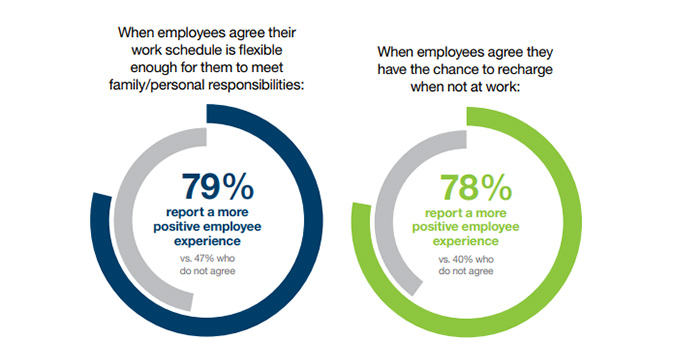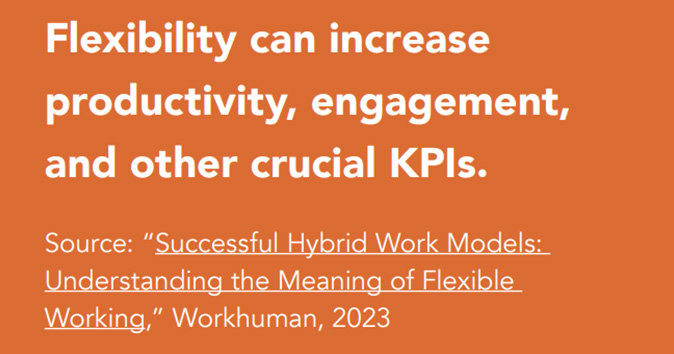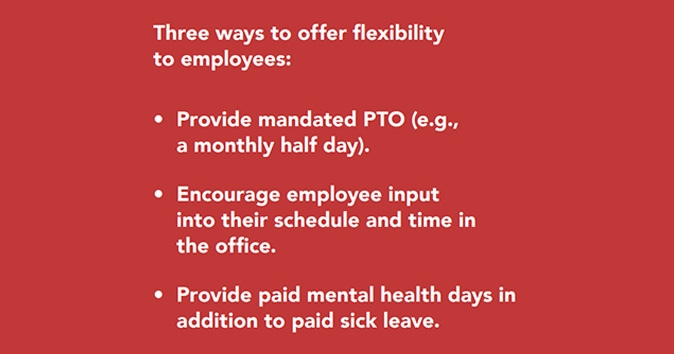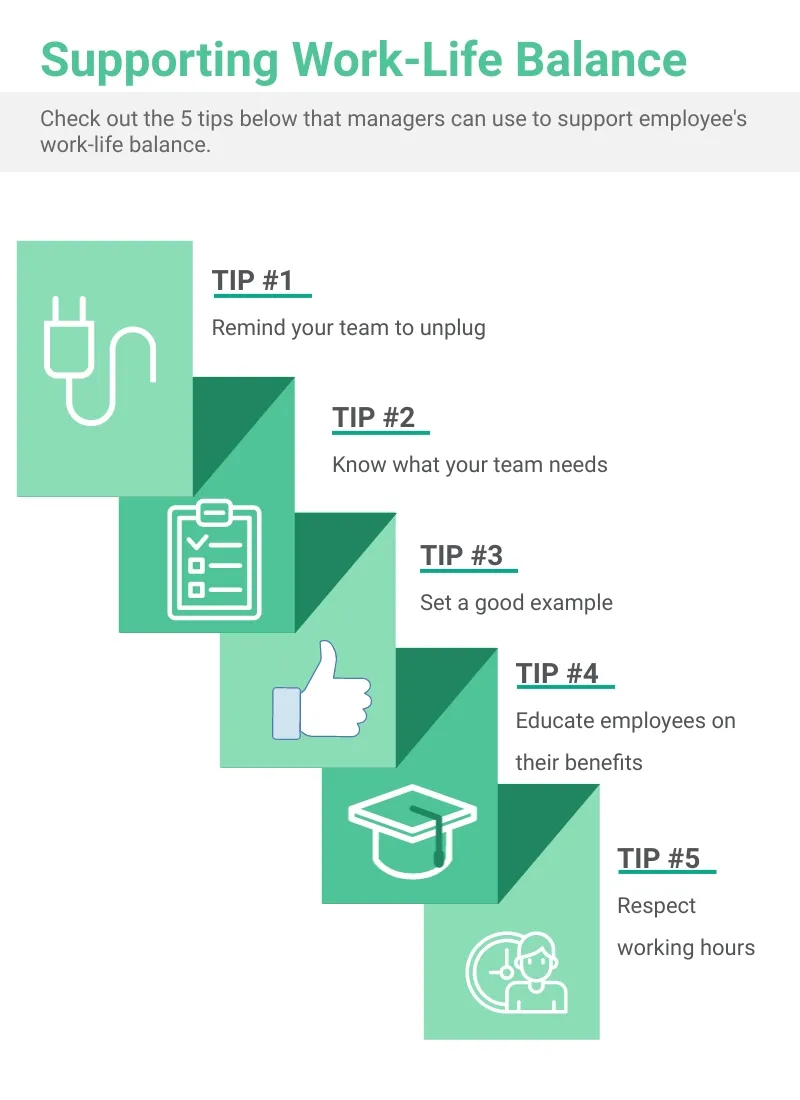Promoting Work-Life Balance: Strategies and Tips

Employee well-being encompasses a bounty of factors, and one of the most significant is work-life balance. Whether an employee finds it feasible to handle the responsibilities of work and their personal life in a way that does not leave them burned out or stressed is a major indication of how collaborative, productive, and present they are at work.
The importance of work-life balance can’t be understated. When employees struggle to find it, they’re more likely to take sick days, look for a new job, and be stressed and burned out. Stress and burnout have a direct impact on the quality of their work, their relationships with coworkers and supervisors, and even their own health.
An organization can play a pivotal role in helping make a work-life balance accessible to its employees. As we’ll learn, making that effort is in the best interest of the employee and the organization.
What does work-life balance mean?
Work-life balance is related to an employee’s ability to take care of all of the responsibilities that come with their job and the responsibilities of their personal life, all while still carving out time to enjoy the hobbies, interests, and activities that bring them joy.
Good work-life balance will look different for every employee, but the general outcomes look similar. They’re happier, more engaged, and more connected. For an organization, the quality of work from an employee with a healthy work-life balance is far superior to that of an employee with a poor work-life balance.

In recent years, as hybrid and remote work has become more commonplace, “work-life balance” has been usurped by “work-life integration” as the most accurate term to describe the definition. That’s because the delineation between work and home life has blurred as more is being done outside of a traditional workplace.
Parents and caretakers, for example, are two groups of employees with unpredictable schedules and increased responsibilities outside of work.
Why is work-life balance important?
Work-life balance is important because it is a vital component of an employee’s overall well-being. And the level of an employee’s well-being influences a lot.
At the employee level, a poor work-life balance can contribute greatly to feelings of stress and burnout, which carry a host of cascading negative effects like poor sleep quality, high blood pressure, strained relationships, and depression.
Conversely, when you help an employee find a better work-life balance, you don’t just negate negative outcomes, you promote positive ones.
The outcomes of good work-life balance
Fewer health problems
With a better work-life balance comes a reduction in the likelihood of stress which can lead to high blood pressure and poor sleep quality.
More engagement
When employees aren’t consistently worrying about whether they’ll be able to get their work done, they’ll have more bandwidth for working with others and improving the quality of their work.
Reduces burnout
When employees successfully find a work-life integration that works for them, they’re less likely to feel burned out and, as a result, less likely to be looking for a new job.
More mindfulness
When employees improve work-life balance, they’re also improving their availability to boost their mental health.
What does a healthy vs unhealthy work-life balance look like?
Healthy work-life balance
In a healthy work-life balance, employees are engaged in their work and personal lives. They’re satisfied with their work hours, they have time to pursue personal interests, and they’re able to carve out quality time with loved ones.
For a parent, that might mean flexible work schedules or the ability to work from home and answer emails after their kids have gone to sleep.

Unhealthy work-life balance
In an unhealthy work-life balance, employees might work long hours and be overwhelmed by the little time remaining to handle personal tasks. Typically, an unhealthy work-life balance is an issue of work responsibilities far outpacing one’s personal life rather than the other way around.
An unhealthy work-life balance can lead to stress, struggles with mental health, and the neglect of personal lives. For example, someone with an unhealthy work-life balance may find it difficult to stop thinking about work outside of working hours and struggle to draw clear boundaries between their job and home life.
It’s crucial that managers and organizations at large understand that some employees might be suffering in silence with an unhealthy work-life balance. If the employee does not feel psychologically safe in the workplace, they might be hesitant to share that they are struggling.
As we’ll discuss in the next section, if managers and leaders are serious about promoting work-life integration, they need to look out for signs that it is not being maintained by all employees.
How to promote work-life balance
While an organization is not wholly responsible for an employee’s ability to strike a healthy work-life balance, it can play a massive role in promoting one. Let’s go over some of the ways employers can help employees achieve work-life balance.
Organizational tactics for achieving work-life balance
Set manageable goals
A massive potential stressor for employees at work is the feeling that they are incapable of achieving the goals of the organization. Some of the time, that could be because the goals themselves are overly ambitious.
While a healthy amount of ambition can breed innovation and push people to achieve, too much of it can leave employees demoralized because they can never hit the mark. Leaders should review the goals they’ve set and determine whether or not they are unmanageable.
One way to make goals more achievable is by using cascading goals examples, which break down larger objectives into smaller, more manageable tasks.
Help employees be more efficient at work
If employees are consistently bogged down in minutia or struggling with cumbersome processes, it could be worth simplifying processes where possible or looking outside the organization for tools that can help employees be more efficient.
Project management and communication tools are especially useful in helping teams stay on the same page and reducing frustration.
Offer flexibility in hours and location

As previously mentioned, flexibility in the form of hybrid and remote work or even in terms of a flexible schedule can be extremely helpful for employees to tackle the responsibilities of work and life more fluidly.
When an organization can define work hours beyond the traditional eight-hour workday, it gives employees the ability to take care of their responsibilities in an optimized way for them.
Encourage personal time off
Personal time off is a huge stress reliever for employees. With it, they can devote time to personal relationships, their physical health, their mental health, and the personal activities that bring them joy.
Investing in their personal life will provide a boon to the employee’s professional life, too. Vacation time allows them to rest, reset, recharge, and come back to work feeling more motivated.
Leaders should encourage employees to use paid time off and make sure there is coverage for their absence so that employees do not walk into a backlog of stress when they return.
Communicate effectively
Work-related stress can stem from employees feeling like they are disconnected from the organization. Transparency and honest communication can help instill a sense of trust in an organization which can reduce the time an employee spends stressing about their standing in the company or even in their future.
5 tips for managers to support their employees’ work-life balance
Managers can play a pivotal role in identifying and alleviating unhealthy work-life integration.
Weekly check-ins should pull double duty as an assessment of an employee’s work performance as well as their overall well-being. Below are some other tips for work-life balance that managers can follow.

Remind your team to unplug
In an always-on world, the lines of work and life get especially blurry. When you can answer emails and messages from your phone, there could be pressure for an employee to tackle a problem as soon as it is seen, even if it's beyond work hours.
Managers should remind teams that work-life balance means letting work play second fiddle sometimes and to close the laptop and respond to that email during work hours.
Know what your team needs
Every team in an organization and every individual within those teams will have unique needs and face different challenges. As a manager, the most effective way to meet those needs and solve those problems is to understand what they are. And there’s no better place to start than with a check-in.
Set a good example
Employees often look to managers as a direct example of how they should behave. If you, as a manager, deprioritize your personal life and neglect your well-being, your employees could very likely follow suit. Conversely, if you strive to find a better balance between work and life, they will likely do the same.
Educate employees on their benefits
In addition to paid time off, many organizations offer physical and mental health benefits to employees, some of which they might not even be aware of. Before an employee’s work-life balance falls off kilter, make sure they are aware of the benefits available to them and how those resources could help reduce stress and create a stronger balance.
Respect working hours
As a manager, your expectations and communications carry additional weight. If you are consistently sending emails after work hours or asking employees to take on tasks without any regard for their current workload, you could be contributing to an unhealthy work-life balance.
Pro tip: If you as a manager work outside of traditional hours, include a disclaimer in emails and other communications that an immediate response is not needed. That sets a clear expectation for how employees should treat such communications so as to not impact their work-life balance.
Conclusion
Work-life balance is one of the most important factors influencing an employee’s stress and engagement. It’s also one of the most important ways to manage well-being at work. It’s in the best interest of employees and the organization as a whole that leaders and managers encourage employees to take advantage of benefits and strategies that could improve this balance.
Ultimately, there is no better way to understand what could be done to help an employee strike a better work-life balance than to speak to them directly about what they need and what’s challenging them.
About the author
Mike Lovett
Mike is a senior content marketing specialist at Workhuman where he writes about the next era of the workplace. Outside the workplace, he’s an avid gardener, a frequent biker, a steadily improving chef, and a fantasy sports fanatic.